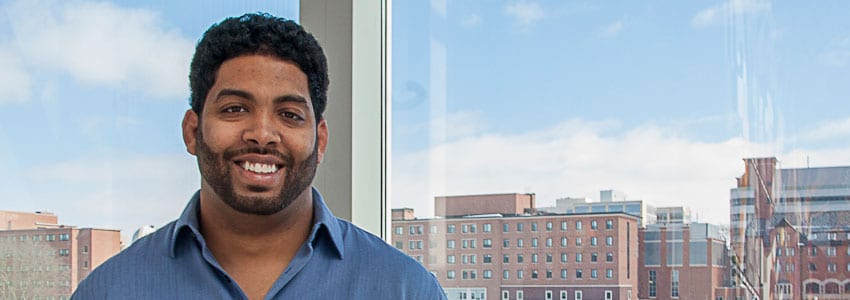Since he was a high school student, Brandon has continued to be involved in organizations that support first generation and minority students in science. Now, he’s working with students in the same capacity and focusing on retention, tutoring, and mentoring. “I would like to stay in academia and am interested in how to make the graduate school experience better for underrepresented students,” he says.
Currently a 5th year doctoral candidate in Bioiformatics, Brandon explains, “What led me into math and physics was the fact that in biochemistry we talked a lot about experimentally-observed protein functions and pathways but very little about how and why these macromolecules develop and perform these various functions – that’s more of a physics kind of question. I decided I wanted to study how these proteins develop structure and function.
A native of Indiana, Brandon attended Indiana University for his undergraduate degree. He says, “I was majoring in biochemistry but discovered biophysics and quantitative sciences, so I stuck around another year to complete math and physics degrees. The following year I was considering applying for quantitative Ph.D. programs, but I only had an experimental/qualitative background and I wanted to do quantitative research. So I searched for different programs that would allow me to develop the needed technical skills. I found out that U-M offers a post baccalaureate program called Prep for those who need a little more training before enrolling in a Ph.D program. I did that for a year and then applied to the bioinformatics Ph.D. program.”
He’s currently working in a computational lab focused on protein structure function and dynamics. He explains, “One of the goals of computational biology is to cheaply figure out what proteins look like and what they’re doing, so experimentally to do this can take several months and a couple hundred thousand dollars, but with the right algorithm it can take a couple of hours and is free.
“Current state of the art algorithms try to use information from images of already solved proteins to predict the structure and function of an unknown protein. Once an initial prediction is made, simple and cheap experiments along with general physical potential are implemented to make the protein images have a higher resolution. I’m usually starting from a medium-level protein image and using really cheap experiments that I can perform in the lab to fix errors in the starting conformation of the protein images so that they can be useful for experimentalists. I’m also currently focused on how two proteins interact with one another, predicting if they will interact, and if so, for how long. Other lab research includes working on genome wide protein interactions, specifically what all the proteins in an organism are doing, how they are related, and how systems adjust if one protein gets knocked out. My lab is focused on making this information easily accessible for others to study.”
For fun, you can often find Brandon on the mat. For the last 15 years, he’s done wrestling, judo and jujitsu recreationally. Or he’ll be coding: “There’s a programing language called Python, and I spend a lot of time using it and developing it in my spare time. I report and attempt to fix bugs I find. I also really like teaching and advising. I like helping people figure out how to break down complex problems into simpler, more doable things. I spend quite a bit of time going through math and physics publications and texts – it’s enjoyable but exhausting.”
Like many doctoral students facing their last year, he is apprehensive about the future. He says, “You read all these things of where doctoral students go after they graduate. Most people come in with the intent of academia, and that’s where I’d like to go, but the path there is becoming more and more questionable. What I’m going to do is THE question. I’ve looked at some of the real world jobs that I would be qualified for and many of these jobs pay well but they aren’t important – there’s no impact. All the impact for someone like me is at the University.”
He’s pleased with the level of support he’s received as a graduate student at U-M: “My department and faculty are very easily approachable and faculty maintain an open door policy. One of the benefits of bioinformatics is the department is built on collaboration and this requires people who are able to communicate well. Students need to have a level of social skills and that makes our department a lot more doable.”
“My involvement with Rackham has been as a participant in and mentor for the Summer Institute and programs for minorities and first generation groups that don’t necessarily have support. This kind of infrastructure of mentoring and pointing people to resources has been helpful for me. Rackham organizes a lot of the social events for grad students – I like those quite a lot. I find it kind of funny of all the things Rackham tries to do to help out their students, the ones that I think help the most are the social events. As a grad student, you spend so much time by yourself, to get a chance to be with other students kind of resets you.”

